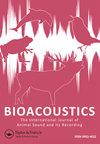The Handbook of acoustic bat detection
IF 2.1
4区 生物学
Q2 ZOOLOGY
Bioacoustics-The International Journal of Animal Sound and Its Recording
Pub Date : 2022-01-19
DOI:10.1080/09524622.2022.2028422
引用次数: 0
Abstract
following a standard format that elaborate on distribution, emergence time, flight and foraging behaviour, habitat types the species is likely to be encountered, echolocation call characteristics, social call characteristics, and species likely to be confused due to overlapping call characteristics. A portrait of the species, a map of their distribution and a tabular summary of their main echolocation call characteristics complement the text. Spectrogram figures of echolocation calls in different environments are provided, as well as those of social calls. Where available, even descriptions of the sounds in heterodyne detectors are given. While describing these species-specific properties, it summarises most topics but goes in depth with echolocation and social calls, and its representation in heterodyne detectors and time expansion/full spectrum recording devices. The authors do not hesitate to clearly state where the former method is insufficient for accurate species identification. In contrast to other books on the market treating the subject, the reader does not find himself lost in a multitude of scatterplots, tables and flowcharts. The text is written in a scientifically sound language, citing relevant scientific articles throughout, but is still easily understandable to laypeople. With 20 pages of literature citations and 9 index pages this book is a very valuable reference, both for beginners interested to learn about echolocation and for experts.蝙蝠声学探测手册
遵循一种标准格式,详细说明了物种的分布、出现时间、飞行和觅食行为、可能遇到的栖息地类型、回声定位呼叫特征、社会呼叫特征,以及可能因重叠呼叫特征而混淆的物种。该物种的肖像、分布图和主要回声定位叫声特征的表格摘要补充了文本。提供了不同环境中回声定位呼叫的频谱图,以及社交呼叫的频谱。在可用的情况下,甚至会给出外差探测器中声音的描述。在描述这些物种特有的特性时,它总结了大多数主题,但深入探讨了回声定位和社会呼叫,以及它在外差探测器和时间扩展/全谱记录设备中的表现。作者毫不犹豫地明确说明了前一种方法不足以准确识别物种的地方。与市场上处理这一主题的其他书籍相比,读者不会发现自己迷失在众多的散点图、表格和流程图中。这篇文章是用科学合理的语言写成的,自始至终都引用了相关的科学文章,但外行仍然很容易理解。这本书有20页的文献引文和9页的索引页,对于有兴趣了解回声定位的初学者和专家来说,都是一本非常有价值的参考书。
本文章由计算机程序翻译,如有差异,请以英文原文为准。
求助全文
约1分钟内获得全文
求助全文
来源期刊
CiteScore
4.50
自引率
0.00%
发文量
25
审稿时长
>12 weeks
期刊介绍:
Bioacoustics primarily publishes high-quality original research papers and reviews on sound communication in birds, mammals, amphibians, reptiles, fish, insects and other invertebrates, including the following topics :
-Communication and related behaviour-
Sound production-
Hearing-
Ontogeny and learning-
Bioacoustics in taxonomy and systematics-
Impacts of noise-
Bioacoustics in environmental monitoring-
Identification techniques and applications-
Recording and analysis-
Equipment and techniques-
Ultrasound and infrasound-
Underwater sound-
Bioacoustical sound structures, patterns, variation and repertoires

 求助内容:
求助内容: 应助结果提醒方式:
应助结果提醒方式:


